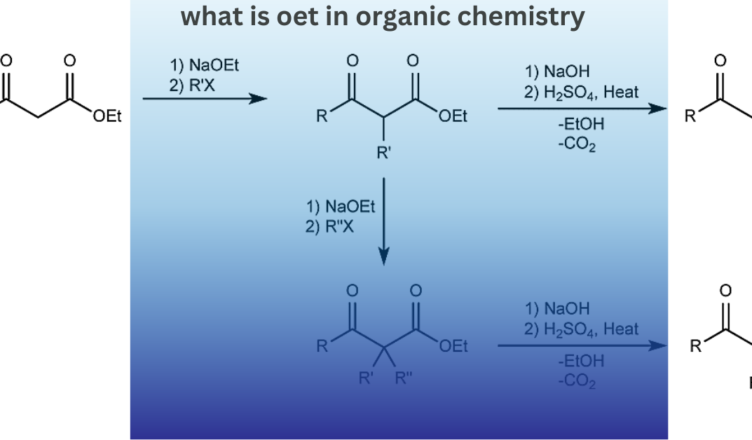In organic chemistry, abbreviations play a significant role in simplifying the representation of complex molecules and reactions. One such abbreviation that often appears in chemical literature and reaction schemes is “OEt.” This guide will explore what does oet mean in organic chemistry, significance, and applications.
What Does OEt Mean?
“OEt” stands for “ethoxy,” which is the ethyl group (-C2H5) attached to an oxygen atom (-O-). The ethoxy group is derived from ethanol (C2H5OH) by removing one hydrogen atom from the hydroxyl group, resulting in the -OEt functional group. In chemical notation, “OEt” is used to represent this functional group in various organic compounds.
Structure of Ethoxy Group
The ethoxy group has the following structure:
H3C-CH2-O-
Here, the oxygen atom is bonded to an ethyl group (-C2H5), forming the ethoxy group (-OEt). The ethoxy group can be part of a larger molecule, where it is bonded to a carbon atom, usually through a single bond.
Significance of OEt in Organic Chemistry
Now that you know what does oet mean in organic chemistry, let’s find out the significance of it. The ethoxy group is significant in organic chemistry due to its presence in various compounds and its role in different chemical reactions. Some key points include:
1. Functional Group in Ethers
One of the primary roles of the ethoxy group is as a functional group in ethers. Ethers are organic compounds where an oxygen atom is bonded to two alkyl or aryl groups. The general formula for ethers is R-O-R’, where R and R’ can be alkyl or aryl groups. When one of the R groups is an ethyl group, the ether is specifically called an ethyl ether, and the structure can be written as R-OEt.
2. Solubility and Solvent Properties
Ethers, including those containing the ethoxy group, have unique solubility and solvent properties. They are often used as solvents in organic reactions due to their ability to dissolve a wide range of organic compounds. Ethoxy-containing ethers, like diethyl ether (Et-O-Et), are commonly used as solvents in laboratory and industrial applications.
3. Stability and Reactivity
The ethoxy group contributes to the stability and reactivity of organic compounds. Ethers are generally stable under neutral conditions but can be reactive in the presence of strong acids or bases. The ethoxy group’s electron-donating properties can influence the reactivity of the molecule it is part of, making it an essential consideration in reaction mechanisms and product stability.
Applications of OEt in Organic Synthesis
The ethoxy group is widely used in organic synthesis due to its versatility and stability. Here are some common applications:
1. Protecting Groups
In organic synthesis, protecting groups are used to temporarily mask reactive functional groups to prevent unwanted reactions. The ethoxy group can act as a protecting group for hydroxyl (-OH) groups, forming ethers that are stable under various reaction conditions. For example, tetrahydropyranyl (THP) ethers are often used to protect alcohols, and the ethoxy group can be part of such protecting groups.
2. Formation of Ethers
The ethoxy group is crucial in the synthesis of ethers through various methods, such as the Williamson ether synthesis. This reaction involves the nucleophilic substitution of an alkyl halide with an alkoxide ion. When the alkoxide ion is ethoxide (EtO-), the resulting product is an ethyl ether.
Example:
R-Br + NaOEt → R-OEt + NaBr
3. Esterification Reactions
Esters are another class of organic compounds where the ethoxy group plays a significant role. Esters are formed by the reaction of carboxylic acids with alcohols, and the ethoxy group is often part of the ester functional group (-COOEt). Esterification reactions are fundamental in the synthesis of various organic compounds, including fragrances, flavors, and pharmaceuticals.
Example:
R-COOH + EtOH → R-COOEt + H2O
4. Nucleophilic Substitution Reactions
The ethoxy group can participate in nucleophilic substitution reactions, where it acts as a nucleophile, attacking electrophilic centers in organic molecules. These reactions are essential in forming carbon-oxygen bonds in organic synthesis.
Example:
R-CH2-Cl + NaOEt → R-CH2-OEt + NaCl
Examples of Compounds Containing OEt
Several organic compounds contain the ethoxy group, each with unique properties and applications. Here are a few examples:
1. Diethyl Ether (Et-O-Et)
Diethyl ether is one of the simplest and most well-known ethers. It is used as a solvent in laboratories and as an anesthetic in medicine. Its structure is:
CH3-CH2-O-CH2-CH3
2. Ethyl Acetate (CH3-COOEt)
Ethyl acetate is a common ester used as a solvent in coatings, adhesives, and pharmaceuticals. It is synthesized by reacting acetic acid with ethanol:
CH3-COOH + C2H5OH → CH3-COOEt + H2O
3. Ethoxybenzene (Phenetole)
Ethoxybenzene, also known as phenetole, is an aromatic ether used in organic synthesis and as a fragrance component. Its structure is:
C6H5-O-CH2-CH3
Practical Considerations in Using OEt
When working with compounds containing the ethoxy group, several practical considerations should be kept in mind:
1. Safety Precautions
Many ethoxy-containing compounds, such as diethyl ether, are highly flammable and can form explosive peroxides. Proper handling, storage, and disposal are crucial to ensure safety in the laboratory.
2. Reaction Conditions
The stability of the ethoxy group under various reaction conditions should be considered. While it is stable under neutral conditions, it can be susceptible to cleavage under acidic or basic conditions, leading to unwanted side reactions.
3. Purification and Characterization
Compounds containing the ethoxy group can often be purified using standard techniques such as distillation and recrystallization. Characterization methods, including NMR and IR spectroscopy, can be used to confirm the presence of the ethoxy group in synthesized compounds.
Conclusion
The ethoxy group (OEt) is a versatile and essential functional group in organic chemistry. Its presence in ethers, esters, and other compounds makes it a key player in various chemical reactions and applications. Understanding what does oet mean in organic chemistry is crucial for students, researchers, and professionals in the field of organic chemistry. By mastering the concepts and applications related to the ethoxy group, one can effectively utilise this functional group in organic synthesis and other chemical processes.

